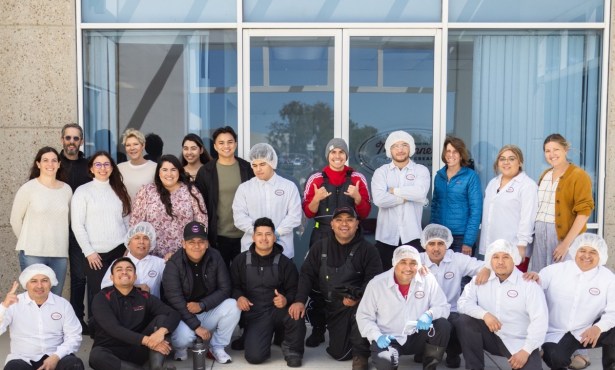Growing in the Goodland:
Goleta’s Zesty History
Unpacking Goleta’s Lemon Industry
By Leslie Dinaberg | September 28, 2023

Check out the rest of our cover story on Goleta history and the Lemon Festival here.
The roots of Goleta’s lemon industry go back wide and deep. Both lemons and oranges were initially brought to California by the Spanish during the establishment of the mission system in the late 18th century, and almost a century later, Sherman Patterson Stow of Goleta’s Rancho La Patera planted the first known commercial lemon orchard in California around 1875. He planted about 3,000 trees, thus making lemons NOT into lemonade, but rather what the Goleta Valley Historical Society describes as “the first irrigated agricultural commodity of Goleta Valley.”
Part of the success of the early lemon industry came from the incorporation of new varieties, such as the thorn-free Eureka lemon and the productive Lisbon lemon. As Stow’s lemons began to thrive and gain renown, Harleigh Johnston, a lemon grower and fruit packer at Montecito’s San Ysidro Ranch, agreed to buy them. By 1881, Rancho La Patera’s lemons were being delivered to Johnston’s packing shed near the wharf, with Stow selling them at 90 cents for 70 pounds. They were transported by wagons with six-horse teams and then loaded onto steamers to send to San Francisco.

According to the Goleta Valley Historical Society, between 1889 and 1892, Johnston also packed lemons on the Stow Ranch itself, using the famous “Mission Brand” label. When a rival packinghouse near Corona began shipping lemons under the Mission brand, a lawsuit followed and the court found in favor of the Goleta growers who had used the trademark first.
As the lemon industry grew, so did the number of organizations involved with it, and in 1896, the Santa Barbara County Lemon Growers’ Exchange was formed. They built a packinghouse and began receiving lemons for shipment that same year. In 1897, the Johnston Fruit Company was incorporated to handle processing, shipping, and marketing of the combined harvests of local lemon growers, naming Stow as the first president.
As the organizations and their ability to do business grew, so did the amount of acreage in Goleta that was devoted to lemons. It increased greatly in the 1930s, and in 1935, the nonprofit, cooperative marketing group — the Goleta Lemon Association — was formed by 60 growers representing 600 acres of lemon trees. The next year, the Goleta Lemon Association opened its packing and storage plant on La Patera Lane in Goleta next to the Southern Pacific Railroad tracks. That first plant employed as many as 350 workers during the peak season, many of whom were women.


[Click to enlarge] Rancho La Patera lemon grove furrow irrigation, 1947 (left) and lemon tree topping by truck. | Credit: Goleta Valley Historical Society
By 1947, the Goleta Lemon Association had grown rapidly and was serving 220 growers who were harvesting 2,300 acres of lemon groves that produced an annual gross of about $3 million.
When the original Goleta Lemon Association plant was destroyed by fire in January of 1950, a new one was built in 1951. Said to be the largest single-unit lemon-processing facility in the world, it had 182,000 square feet of floor space and the capacity to process 2,000 carloads of lemons a year.
“Carloads” come up a lot in researching the agricultural history of lemons. During its first six months of operation, the Goleta Lemon Association shipped 306 carloads of lemons to cities across the United States; eight years later, in 1943, they shipped 900 carloads; and in 1947, they shipped 1,200 carloads. How many lemons a 1947 car actually holds is another question — and possibly a good contest for the next Goleta Lemon Festival to sponsor! How many lemons can this car hold, and how many lemon meringue pies will they make?
Another fun fact from this era in our agricultural history is that the iconic Goleta Lemon Association brand labels have a hierarchical meaning beyond their names. The labels included “Goleta” and “San Marcos,” which were “top quality”; “La Patera,” which was “extra choice”; “Schooner,” “Channel,” and “Arboleda,” which were “choice”; and “Estero,” which was “standard.”

Prior to 1950, the Goleta Lemon Association was the fourth- or fifth-largest (depending on yearly production totals) shipper of fresh lemons in the United States. Lemon acreage in Santa Barbara County hit its peak in 1957 with 9,328 acres planted. During the years 1943-1961, Santa Barbara County’s annual lemon crop was worth $6-8 million, according to data from the Goleta Valley Historical Society.
The Goleta Lemon Association operated until 1978, at which time its packing plant was closed. By 2002, only 1,904 acres of lemons were in production. That number of acres of lemons harvested in 2022 was 1,618, according to the most recent (2022) Santa Barbara County Agricultural Report. The total value of that crop was reported to be $13.1 million.
While lemons are no longer the top crop in our county — strawberries continue to top that list by a very large margin, accounting for 82 percent of the $989 million in fruit and nut crops reported in 2022 — according to the March 2023 US Department of Agriculture, National Agricultural Statistics Service Crop Production report, 95 percent of the country’s lemons are now supplied by farms in California. So having Goleta as the home of the first known commercial lemon orchard in California is certainly a part of our history worth celebrating.














You must be logged in to post a comment.